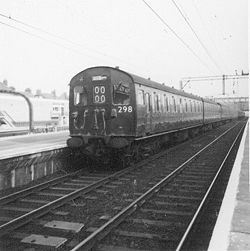British Rail Class 302
| British Rail Class 302 | |
|---|---|

Class 302 at Barking
|
|
| In service | 1958 - 1999 |
| Manufacturer | BR York Works and Doncaster |
| Refurbishment | 1981 - 1982 (All) 1992 (3 mail conversions) |
| Number built | 112 trainsets |
| Formation | 4 Cars per Trainset |
| Capacity | 344 seats |
| Specifications | |
| Maximum speed | 75 mph (121 km/h) |
| Weight | 155 t (153 long tons; 171 short tons) |
| Electric system(s) | 25 kV AC Overhead Originally = 6.25/25 kV |
| Track gauge | 1,435 mm (4 ft 8 1⁄2 in) standard gauge |
The British Rail Class 302 (pre-TOPS AM2) was a type of electric multiple unit (EMU) introduced between 1958 - 1960 for outer suburban passenger services on the London, Tilbury and Southend Railway route. This class of multiple unit was constructed using the Mark 1 bodyshell and was slam-door.
Each unit was formed of four coaches in the formation BDTS - MBS - TC - DTS. The initial set numbers were 201-312, later prefixed by the class number 302.
They were among the first 25 kV units delivered to the Eastern Region, and although ordered for the LT&S electrification, which route they were long associated with, they were used initially on the Liverpool Street to Southend Victoria line from the day this was converted from DC to AC power, covering the period while the former DC units were rebuilt to AC. The first 20 units remained on the GE main line for the bulk of their lives, with the remainder operating on the LT&S from Fenchurch Street from 1962.
Like all the Eastern Region AC EMUs of the period, they were equipped to operate on both 25 kV AC and the reduced 6.25 kV voltage in the inner London areas where headroom for the overhead wires was reduced. On the LT&S the changeover point was just east of Barking station on both Upminster and Tilbury routes.
Trailer coaches were originally fitted with Gresley bogies which were replaced on Driving Trailer (DT) and Trailer Standard Open (TSO) which was formerly Composite Trailer and B5 Bogies on Battery Driving Trailer which became Battery Composite Trailer, the refurbishment moved First class accommodation to a position over the Westinghouse CM38 main compressor which was noisy and caused vibration. The Motor Coach retained its Gresley derived bogies after refurbishment.
The Battery Driving Trailer and Driving Trailer were fitted with drop head buckeye couplers with screw coupler in the Guards Van, retractable buffers are also fitted only on outer ends of the Battery Driving Trailer/Driving Trailer.
Originally the vehicles were insulated with "blue" asbestos which was removed and sealed during refurbishments.
...
Wikipedia
